537
3 and 5: When the working week was five days?
Five-day working week is the result of the industrial revolution of XVIII–XIX centuries. Then there was a transition from agrarian economy to industrial production, and there are plenty of mills and factories, which needed to be adjusted. First, their employees worked during daylight, 12 hours a day. However, with the advent of electricity, the volume of working time is increased; this resulted in protests and led to the formation of the first labour unions — for example, National associations of labor in the United States, which advocated the reduction of the working day.
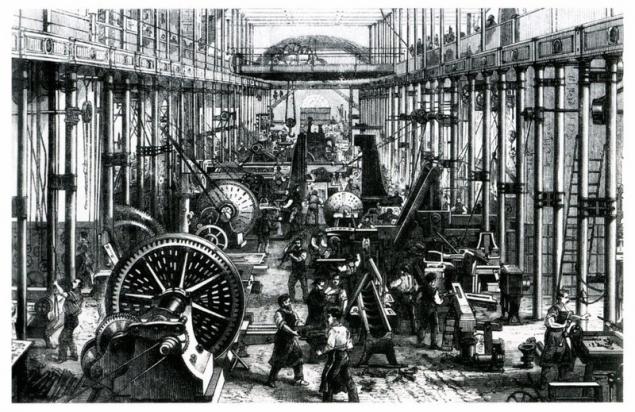
Saxon Engineering Factory 1868 © wikipedia
In the agrarian society, the traditional output was only Sunday — this day was made to go to Church. The industrial world also initially stuck to the established six-day system, but then Western society gradually began to move away from it under the pressure of public protests and authors of the first scientific studies confirmed: a ten-hour workday without a lunch break leads to exhaustion, which is bad for performance. Already in 1926, the founder of the Ford Motor company, Henry Ford began closing his factories on Saturday and Sunday. At this point, the number of hours worked per week in the United States has decreased from 80 to 50. Ford came to the conclusion that this amount is easier to divide by 5, not 6 days, freeing more time for leisure activities and the growth in consumer demand.
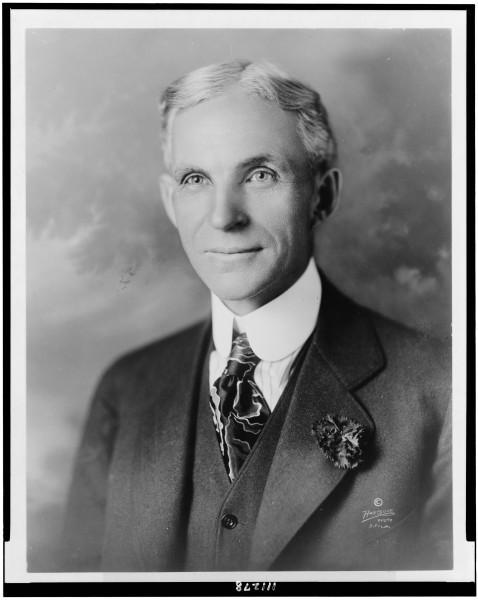
Henry Ford © wikipedia
In Russia the picture was different. In the late nineteenth century, the working hours here are still not regulated and accounted for 14-16 hours a day. Only in 1897, under pressure from the labor movement, especially the weavers of the Morozovskaya manufactory in Ivanovo, a working day was first legally restricted to 11 and a half hours from Monday to Friday and 10 hours on Saturday for men and up to 10 hours each day for women and children. However, the law does not regulate overtime work, so that in practice the working time remained unlimited.
Changes occurred only after the October revolution of 1917. Then came the decree of the Council of people's Commissars, established the schedule of work of the enterprises. It said that working time should not exceed 8 hours per day and 48 per week including the time needed to care for the machine and the working premises. Nevertheless, the working week in the Soviet Union after that time remained a six-day another 49 years.
From 1929 to 1960, the Soviet working day has experienced several major changes. In 1929 it was reduced to 7 hours (a working week to 42 hours), but began the transition to the new service calendar — in connection with the introduction of a continuous production system. Calendar week because of this cut down to 5 days: four workers for 7 hours each, and the 5th — day off. The country even began to leave pocket calendars, one side of which was printed Gregorian week, and the other personnel. At the same time for people's commissariats and other institutions since 1931, the schedule was a special: here is a calendar week was six days, and the 6th, 12th, 18th, 24th and 30th of each month, and March 1 was inoperable.
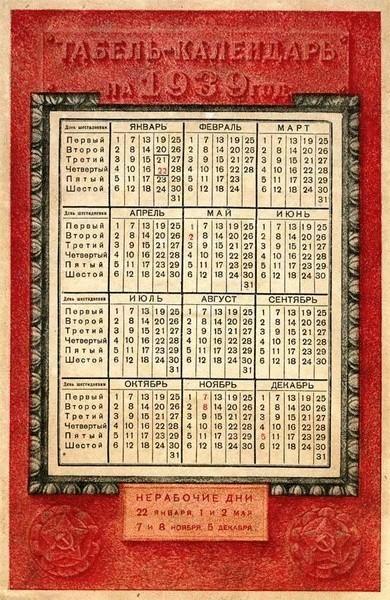
The calendar provides trainings for five days © wikipedia
The Gregorian calendar has returned to the Soviet Union only in 1940. The week was again seven days: 6 working days, one (Sunday) — closed. Working hours thus increased again to 48 hours. The great Patriotic war has added to this time mandatory overtime 1 to 3 hours a day, and the holiday was cancelled. Since 1945 measures of wartime ceased to operate, but only by 1960 the work week back to its former volumes: 7 hours per day, 42 hours. Only in 1966, at the XXIII Congress of the CPSU, the decision was made to switch to five days with eight-hour working day and two days off: Saturday and Sunday. In educational institutions the six days survived.
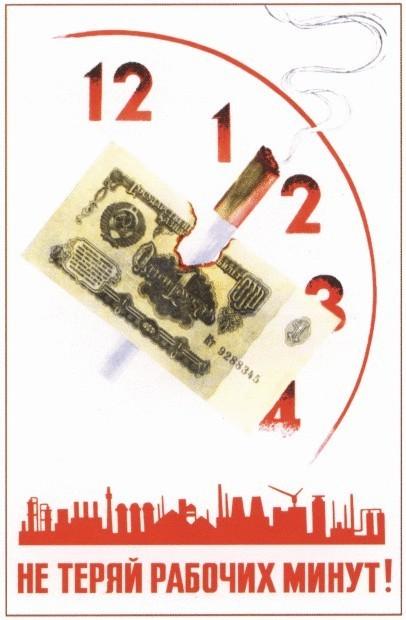
1968 Rudkevich A. don't lose working minutes! © wikipedia
"The idea of the introduction of the 40-hour work week in the world was formed around 1956 and the early 60s was implemented in most European countries, — says Nikolay Bai, Professor, Department of civil law of the law Institute peoples' friendship University. — Initially this idea was proposed to the international labour organization, after which leading and emerging economies began to apply it in practice. In different countries, however, the amount of staff time is still different: for example, in France the week of 36 hours. The main reason is that the degree of development of the economy differs from country to country. In the framework of a developed economy does not make sense to drive people, and there are possible a shorter working week, to allow people more time to devote to yourself, your health and family. By the way, in the recent past in Russia, Mikhail Prokhorov has proposed to introduce in Russia the 60-hour working week. In response, the government asked the question: "do You want to in our country, there was another revolution?"
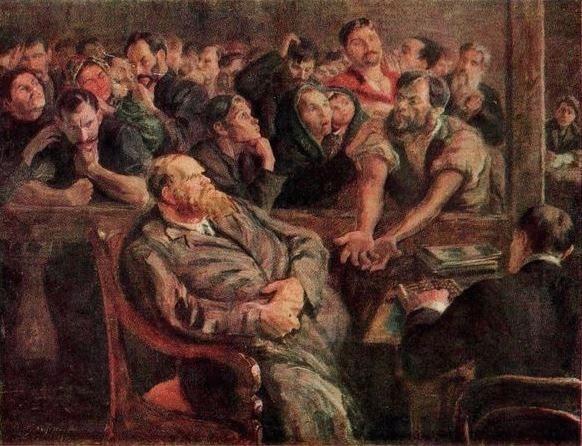
N. And. Verkhoturov "Calculate" ("Front strike")
In most countries, a five-day week remains a preferred. It is believed that this is the classic version of working time, created on the basis that 8 hours a person spends asleep 8 (not counting the hour for lunch) to work, and the remaining 8 hours for yourself. Per week working time is distributed evenly, so that it is possible to work and relax. Plus we have two days off to freshen up, relax and do family things."published
P. S. And remember, only by changing their consumption — together we change the world! ©
Source: theoryandpractice.ru

Saxon Engineering Factory 1868 © wikipedia
In the agrarian society, the traditional output was only Sunday — this day was made to go to Church. The industrial world also initially stuck to the established six-day system, but then Western society gradually began to move away from it under the pressure of public protests and authors of the first scientific studies confirmed: a ten-hour workday without a lunch break leads to exhaustion, which is bad for performance. Already in 1926, the founder of the Ford Motor company, Henry Ford began closing his factories on Saturday and Sunday. At this point, the number of hours worked per week in the United States has decreased from 80 to 50. Ford came to the conclusion that this amount is easier to divide by 5, not 6 days, freeing more time for leisure activities and the growth in consumer demand.

Henry Ford © wikipedia
In Russia the picture was different. In the late nineteenth century, the working hours here are still not regulated and accounted for 14-16 hours a day. Only in 1897, under pressure from the labor movement, especially the weavers of the Morozovskaya manufactory in Ivanovo, a working day was first legally restricted to 11 and a half hours from Monday to Friday and 10 hours on Saturday for men and up to 10 hours each day for women and children. However, the law does not regulate overtime work, so that in practice the working time remained unlimited.
Changes occurred only after the October revolution of 1917. Then came the decree of the Council of people's Commissars, established the schedule of work of the enterprises. It said that working time should not exceed 8 hours per day and 48 per week including the time needed to care for the machine and the working premises. Nevertheless, the working week in the Soviet Union after that time remained a six-day another 49 years.
From 1929 to 1960, the Soviet working day has experienced several major changes. In 1929 it was reduced to 7 hours (a working week to 42 hours), but began the transition to the new service calendar — in connection with the introduction of a continuous production system. Calendar week because of this cut down to 5 days: four workers for 7 hours each, and the 5th — day off. The country even began to leave pocket calendars, one side of which was printed Gregorian week, and the other personnel. At the same time for people's commissariats and other institutions since 1931, the schedule was a special: here is a calendar week was six days, and the 6th, 12th, 18th, 24th and 30th of each month, and March 1 was inoperable.

The calendar provides trainings for five days © wikipedia
The Gregorian calendar has returned to the Soviet Union only in 1940. The week was again seven days: 6 working days, one (Sunday) — closed. Working hours thus increased again to 48 hours. The great Patriotic war has added to this time mandatory overtime 1 to 3 hours a day, and the holiday was cancelled. Since 1945 measures of wartime ceased to operate, but only by 1960 the work week back to its former volumes: 7 hours per day, 42 hours. Only in 1966, at the XXIII Congress of the CPSU, the decision was made to switch to five days with eight-hour working day and two days off: Saturday and Sunday. In educational institutions the six days survived.

1968 Rudkevich A. don't lose working minutes! © wikipedia
"The idea of the introduction of the 40-hour work week in the world was formed around 1956 and the early 60s was implemented in most European countries, — says Nikolay Bai, Professor, Department of civil law of the law Institute peoples' friendship University. — Initially this idea was proposed to the international labour organization, after which leading and emerging economies began to apply it in practice. In different countries, however, the amount of staff time is still different: for example, in France the week of 36 hours. The main reason is that the degree of development of the economy differs from country to country. In the framework of a developed economy does not make sense to drive people, and there are possible a shorter working week, to allow people more time to devote to yourself, your health and family. By the way, in the recent past in Russia, Mikhail Prokhorov has proposed to introduce in Russia the 60-hour working week. In response, the government asked the question: "do You want to in our country, there was another revolution?"

N. And. Verkhoturov "Calculate" ("Front strike")
In most countries, a five-day week remains a preferred. It is believed that this is the classic version of working time, created on the basis that 8 hours a person spends asleep 8 (not counting the hour for lunch) to work, and the remaining 8 hours for yourself. Per week working time is distributed evenly, so that it is possible to work and relax. Plus we have two days off to freshen up, relax and do family things."published
P. S. And remember, only by changing their consumption — together we change the world! ©
Source: theoryandpractice.ru






















